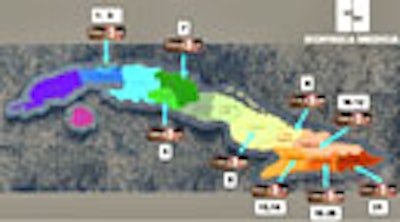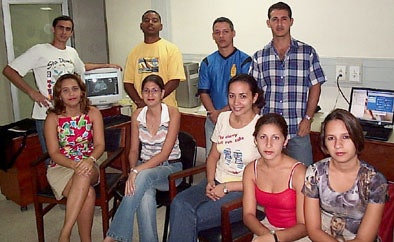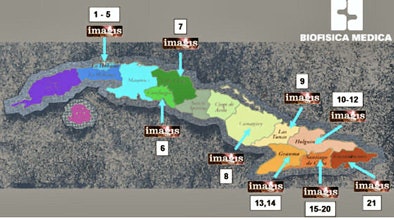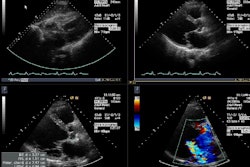
The Cuban National Health System (CNHS) faced daunting challenges in its efforts to develop a PACS system that would connect the country's far-flung health facilities, and support the flow of image data between big city hospitals and remote clinics in hard-to-access rural regions.
Given the economic and political realities of the island nation, the system would have to be built without benefit of large budgets or legions of imported consultants. It would have to connect multiple healthcare centers scattered throughout a 42,804-square-mile island comprising a land mass larger than Austria's, with a divergent but mostly low-bandwidth communications infrastructure.
Finally, the network would have to efficiently link everything from big city hospitals equipped with multiple imaging modalities to rural clinics without a scrap of imaging equipment.
But developers from the University of Oriente in Santiago de Cuba overcame the obstacles to design and build a PACS that works, according to Adrian Vazquez, Patricio Lumumba, Henry Blanco Lores, Dismer Betancourt, Fernando Fuente, Abel Vadell, and colleagues from the university's Medical Biophysics Center.
 |
| Current members of the IMAGIS development team include (women, left to right) Linnet Fernandez, Gretell Matos, Elagnie Fonseca, Marisleidis Perdomo Osorio, and Sucel Marrero Torres; and (men, left to right) Abel Cruz, Adrian Vazquez, Henry Blanco, and Rodney Cuza. Photo courtesy of Adrian Vazquez. |
Launched in 1998, the IMAGIS system has grown steadily to encompass 21 sites located in 10 of the island's 14 provinces. And after more than five years of testing and refinement, CNHS in 2004 embraced IMAGIS as the official Cuban PACS network.
AuntMinnie.com spoke with Vazquez this summer at the Computer Assisted Radiology and Surgery (CARS) 2005 meeting in Berlin, and thereafter via e-mail, translating his remarks for this story from Spanish.
"The IMAGIS network is installed in 21 hospitals, in 10 of 14 of Cuba's provinces," Vazquez wrote. "Image transmission is carried out in two ways: within the healthcare institution using TCP/IP intranet and DICOM protocol, and externally using DICOM and e-mail protocols, enabling teleradiology and second-opinion consults. Image transmission now occurs at rates of at least 256 kbps."
Preliminary steps have been taken to eventually increase the connection speed to 512 kbps in 50 of the country's most important medical centers, Vazquez added.
A growing network
The first phase of the installation linked the most important hospitals in the five eastern provinces: Guantánamo, Santiago de Cuba, Granma, Holguín, and Las Tunas. Phase two linked the Havana hospitals. Recently, hospitals in the central region were incorporated.
Since 1998 more than 100,000 imaging studies have passed through the system, and approximately 2 million images have been archived in the 21 centers, the researchers reported. IMAGIS is currently being extended to the remaining four provinces of Cuba.
The network supports C-Store, C-Find, C-Move, N-Get, and N-Action DICOM servers and client services classes (SCU, SCP), the group explained in its poster presentation. The St. Louis-based Mallinckrodt Institute of Radiology's Central Test Node (MIR CTN) and DICOM tool kit (DCMTK) libraries were used for DICOM implementation.
"Each hospital has its own data archive and servers," Vazquez wrote. "Hospitals exchange images when they need second opinions, and do not share a centralized archive." Moreover, each hospital has its own information system (HIS), which is not linked to IMAGIS.
For communications between far-flung regional clinics, the system supports the sending and receiving of images by e-mail using standard Simple Mail Transfer Protocol (SMTP) and Post Office Protocol (POP3). Multipurpose Internet Mail Extensions (MIME) were used to code DICOM images for attachments to mail messages using lossy jpeg compression to ensure manageable file sizes, the group explained.
"Images are sent to the department image server from each of the imaging modalities," Vazquez wrote. "The radiologists access the studies stored on this server. They interpret and report the cases, then select images to send to the hospital's central image server. These images can then be accessed from the workstations in different departments and locations such as intensive care, operating rooms, medical specialists, etc."
Thus, IMAGIS functions as PACS software, a radiology tool, a workstation, and as an image server in the various radiology departments, Vazquez wrote. Hospitals can archive studies from all the imaging modalities, including MRI, CT, ultrasound, nuclear medicine, and even brain electrical tomography (EEG/MEG) in their archives.
 |
 |
||||
| No. | Province | Institution | No. of beds | Installation |
 |
||||
| 1 | Havana | Hermanos Ameijeiras Clinical and Surgical Hospital | > 400 | June 2002 |
| 2 | Havana | CIMEQ-CIREN | > 400 | July 2001 |
| 3 | Havana | William Soler Pediatric Hospital | > 400 | June 2003 |
| 4 | Havana | Juan M. Márquez Pediatric Hospital | > 400 | June 2003 |
| 5 | Havana | Frank País Orthopedic Hospital | > 400 | November 2003 |
| 6 | Cienfuegos | Gustavo Aldereguía University Hospital | > 400 | November 2004 |
| 7 | Villa Clara | Arnaldo Milián University Hospital | > 400 | November 2004 |
| 8 | Camagüey | Manuel Ascunce Provincial Hospital | > 400 | October 2004 |
| 9 | Las Tunas | Ernesto Che Guevara Provincial Hospital | > 400 | December 2001 |
| 10 | Holguín | Lucía Iñiguez Clinical and Surgical Hospital | > 400 | July-August 2003 |
| 11 | Holguín | Vladimir I. Lenin Hospital | 400+ | November 2000 |
| 12 | Holguín | Octavio de la C Pediatric Hospital | > 200 | April 2004 |
| 13 | Granma | Celia Sánchez Clinical and Surgical Hospital | > 400 | December 2001 |
| 14 | Granma | Carlos M. Céspedes Provincial Hospital | > 400 | November 2000 |
| 15 | Santiago de Cuba | Saturnino Lora Provincial Hospital | 400+ | May 2003 |
| 16 | Santiago de Cuba | Joaquín C. Duany Military Hospital | > 200 | May 2003 |
| 17 | Santiago de Cuba | Gen. Santiago Clinical and Surgical Hospital | > 400 | May-December 2003 |
| 18 | Santiago de Cuba | Ambrosio Grillo Clinical and Surgical Hospital | > 200 | May 2003 |
| 19 | Santiago de Cuba | Interprovince Oncologic Hospital | > 100 | November 2003 |
| 20 | Santiago de Cuba | Sur Children's Hospital | > 200 | May 2003 |
| 21 | Guantánamo | Agostinho Neto Provincial Hospital | > 400 | November 2001 |
 |
||||
The IMAGIS PACS network now serves 21 hospitals in 10 Cuban provinces. Data and image courtesy of Adrian Vazquez.
Shared responsibilities
Radiologists and the PACS administrators work together to keep the system humming.
"Generally, it is radiologists who use IMAGIS for their daily work and to communicate among themselves, though the system can also be used by nonradiologists," Vazquez wrote.
"To date, nonradiologists' use of the system has been limited to accessing images, examining them, and keeping certain data of interest in their archives -- we're talking about neurologists, radiotherapists, orthopedic and other surgeons, general practitioners, and others," he continued. "But the diagnostic work is the responsibility of the radiologists, who are the only specialists authorized to use the teleradiology component."
Training is generally conducted one center at a time, as part of the installation process, and also in regional training sessions, which have been conducted across the island nation.
Each facility has a system administrator who is responsible for keeping the system running 24/7. The PACS administrators are also the principal source of feedback for the development team, which now numbers more than 20 professionals -- mostly young people with great enthusiasm and a broad range of technical backgrounds, Vazquez wrote.
Data are sent from the modalities to the IMAGIS server, and the radiologist accesses the images at a workstation by means of DICOM query/retrieve protocols, the group explained. Open-database connectivity enables interaction with data sources when identifying information is available for the images. Web-based image retrieval is not yet supported.
In five years IMAGIS has enabled the creation of a comprehensive fully functional PACS in Cuba, the team reported. It has fostered better understanding of the systems and technology, improved medical care and quality of life for patients, and demonstrated the advantages of developing such a system on a large scale.
This IMAGIS solution is especially positive for underdeveloped countries such as Cuba, where medical imaging modalities are rare, and commercial PACS systems are prohibitively expensive, the group wrote.
The combination of DICOM and e-mail protocols for various network environments are key factors enabling expansion of the system to diverse and low-cost hardware platforms, the team concluded.
By Eric Barnes
AuntMinnie.com staff writer
September 29, 2005
Additional reporting for this article by AuntMinnie.com contributing writer Cynthia Keen.
Related Reading
3D ultrasound offers reliable assessment of gallbladder, bile ducts, May 2, 2003
Cuban radiologists rely on transcranial ultrasound, July 4, 2002
ITL brings homegrown PACS to the masses, November 1, 2000
Copyright © 2005 AuntMinnie.com



















